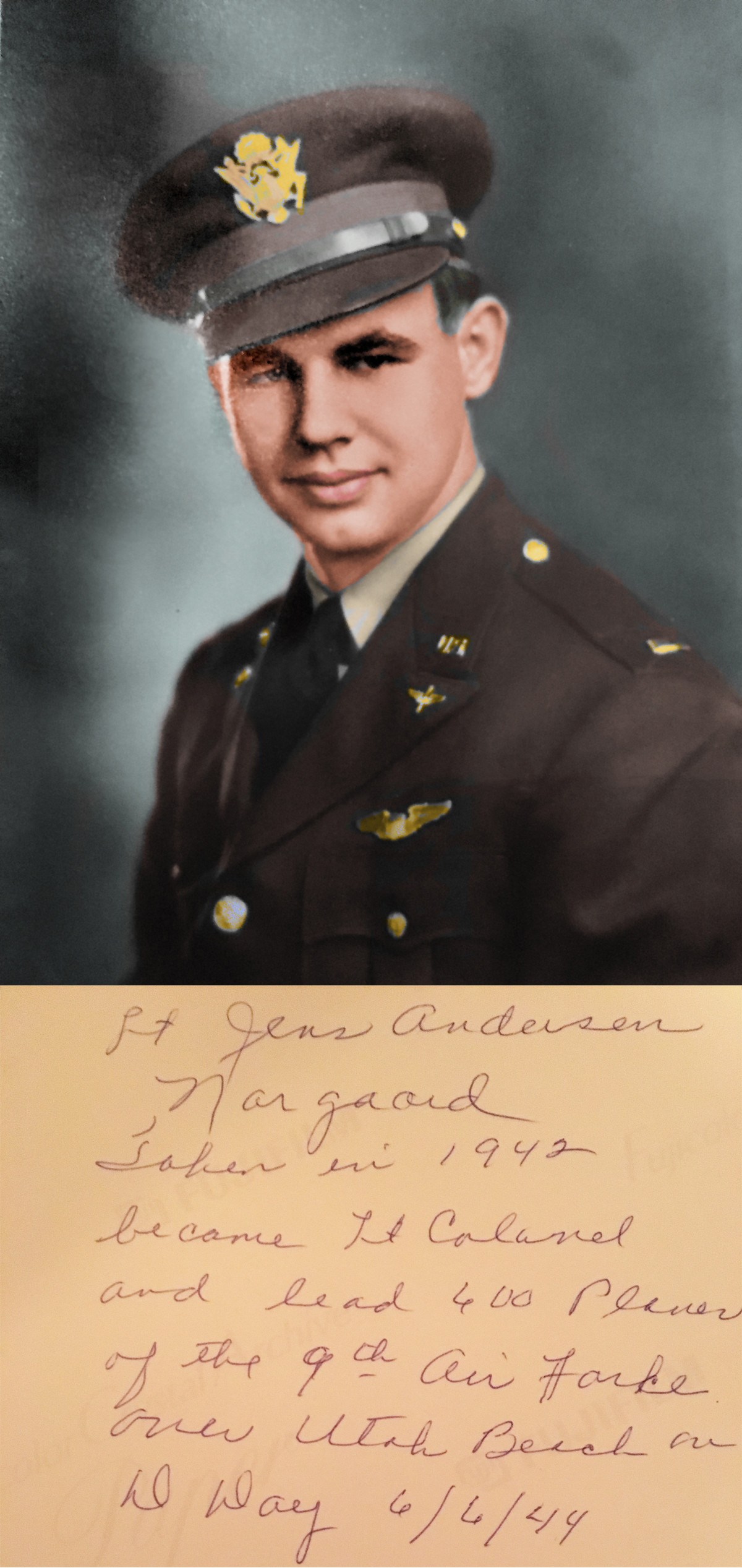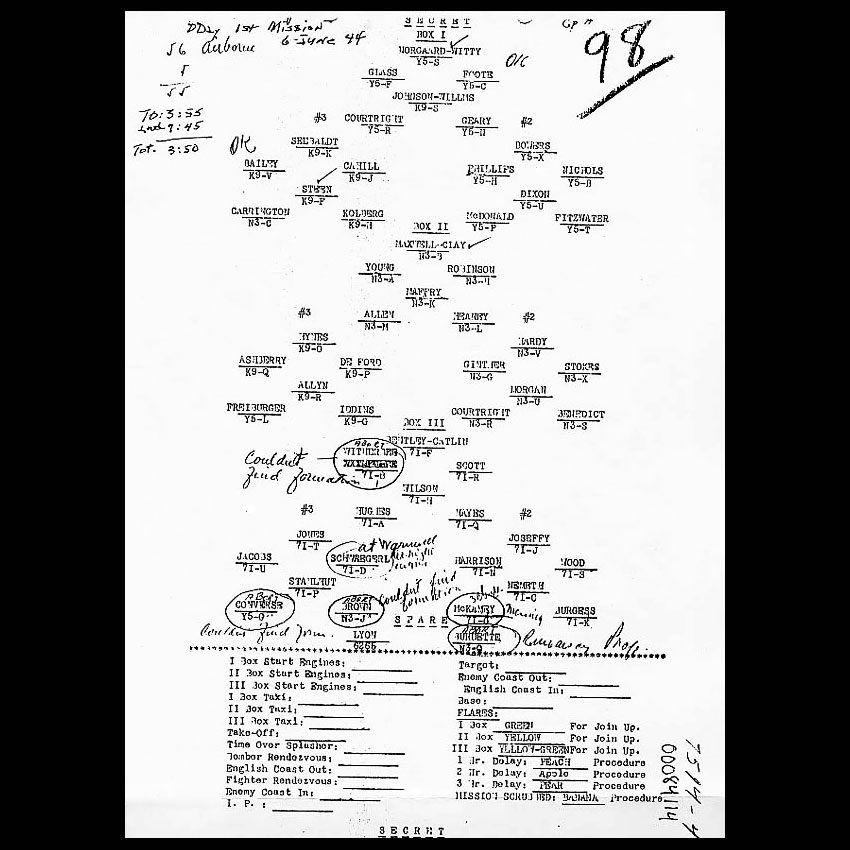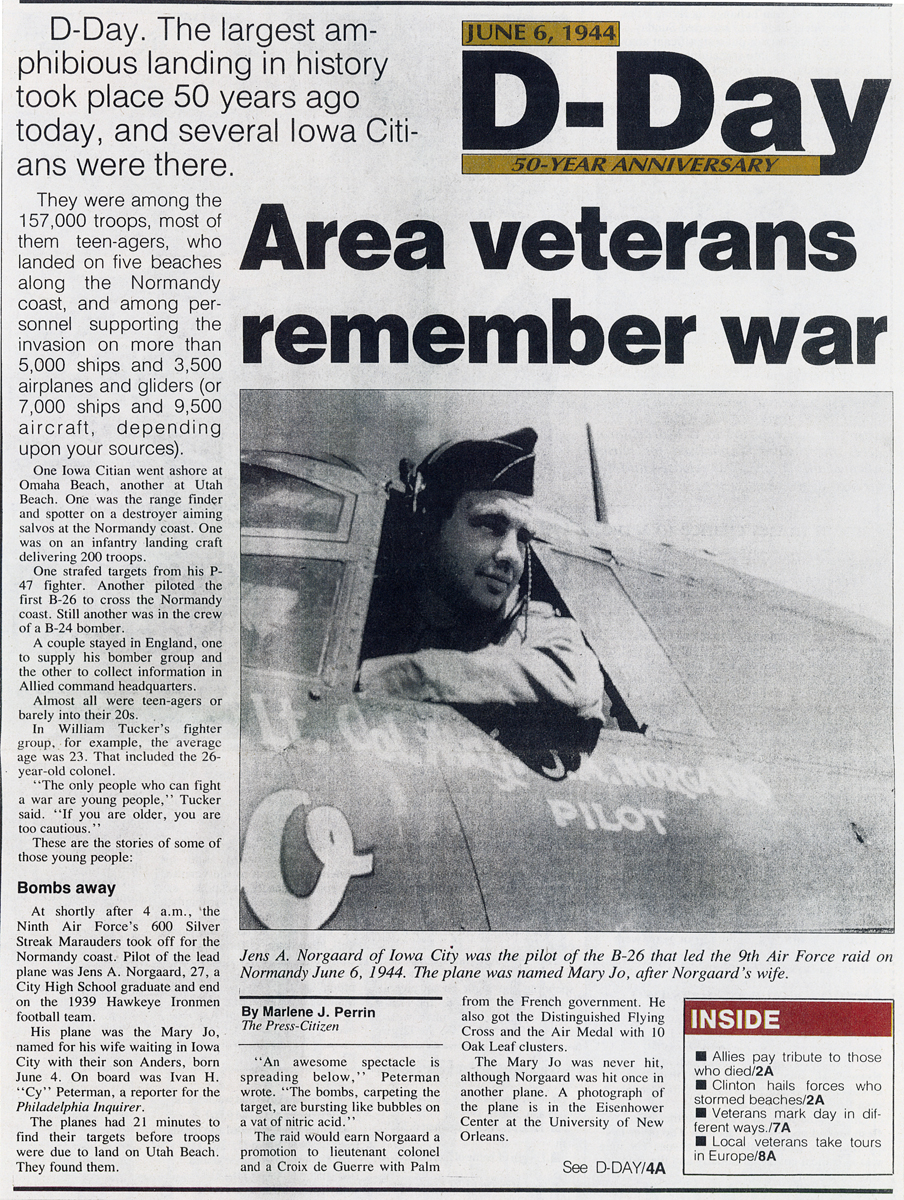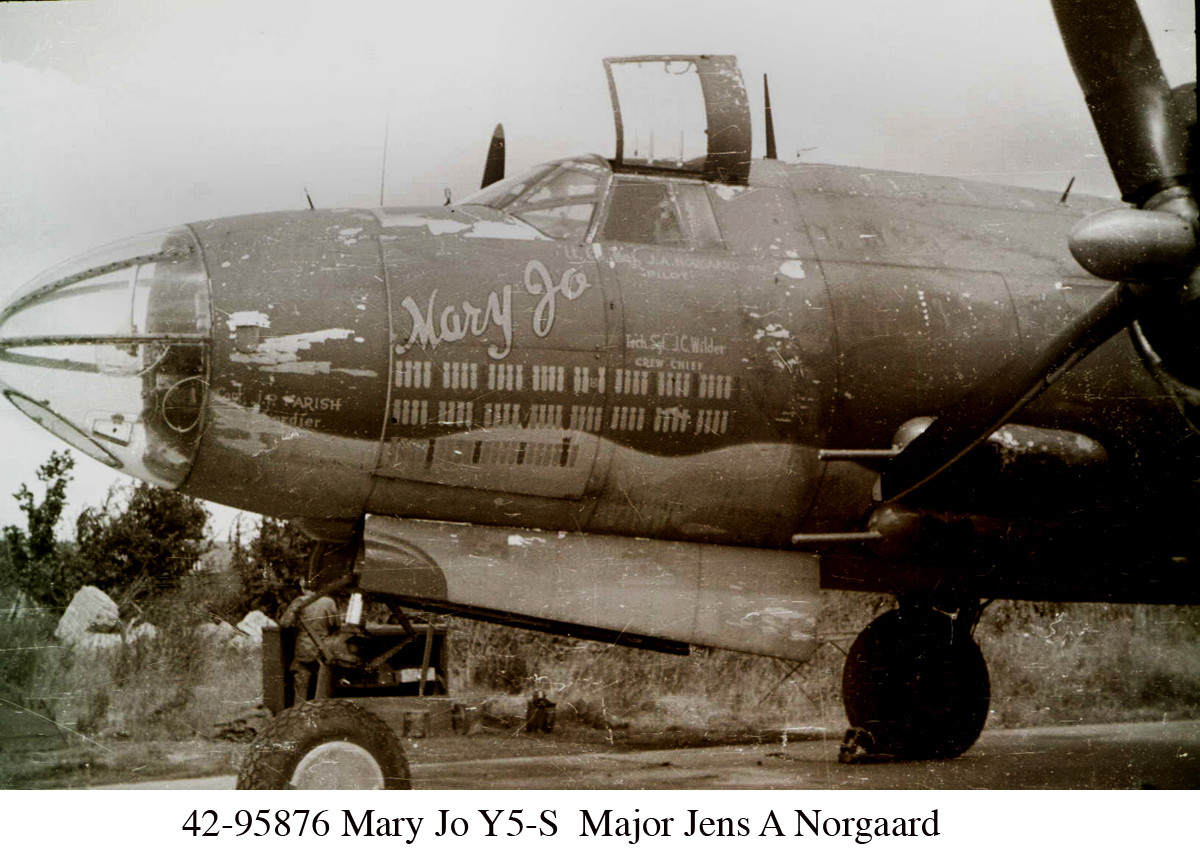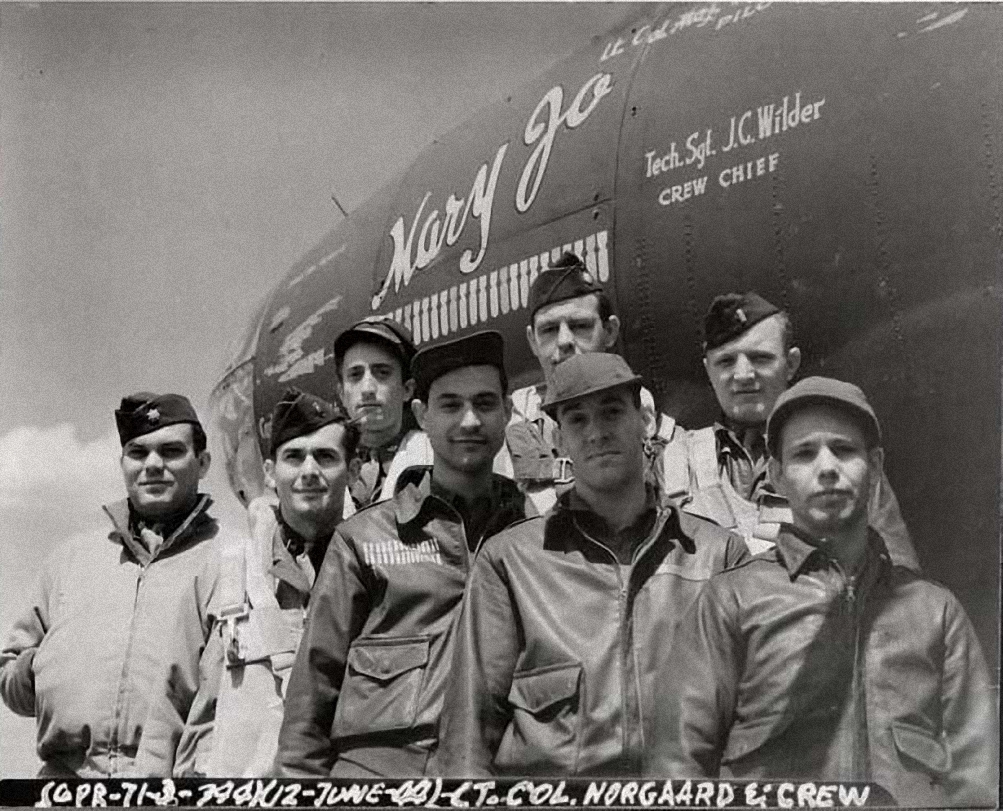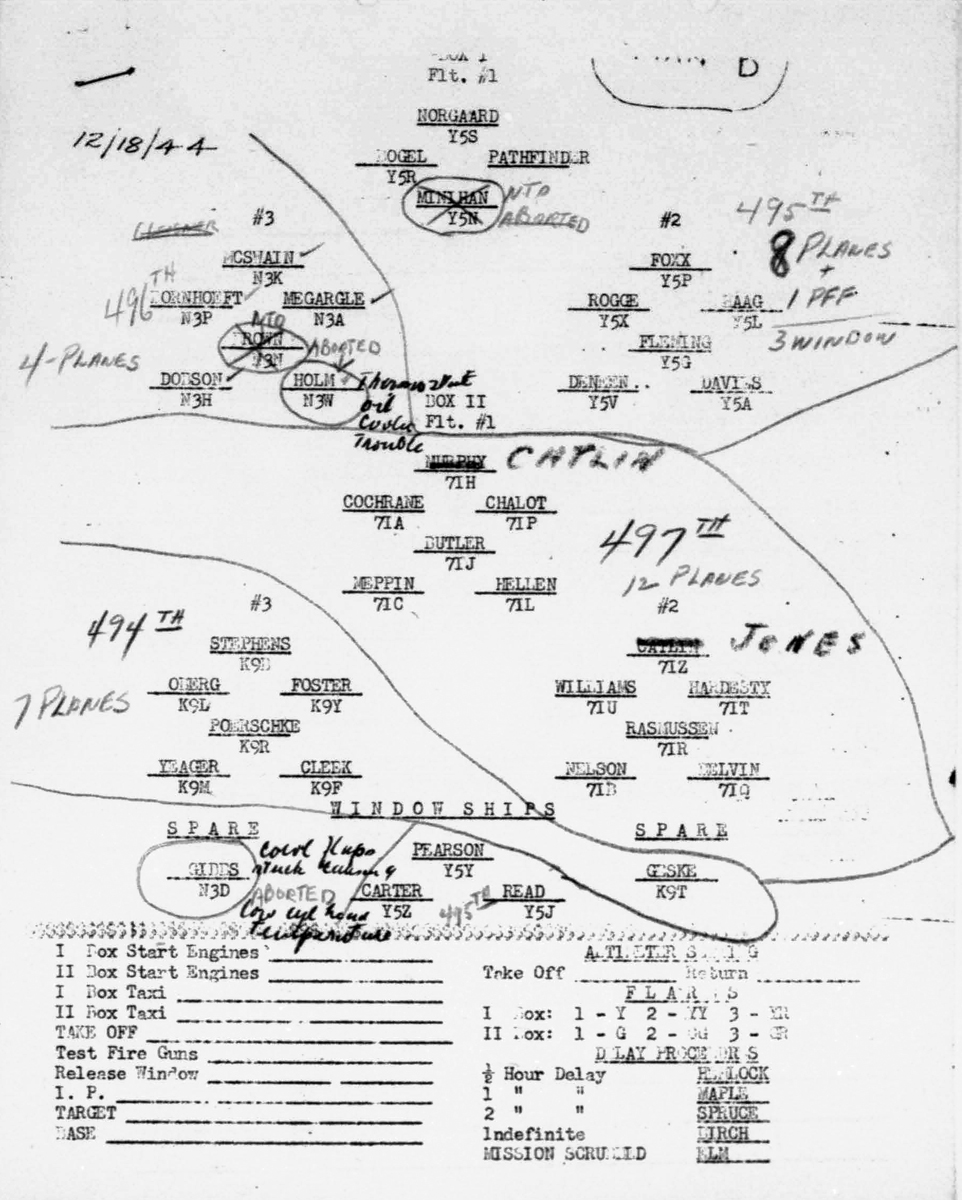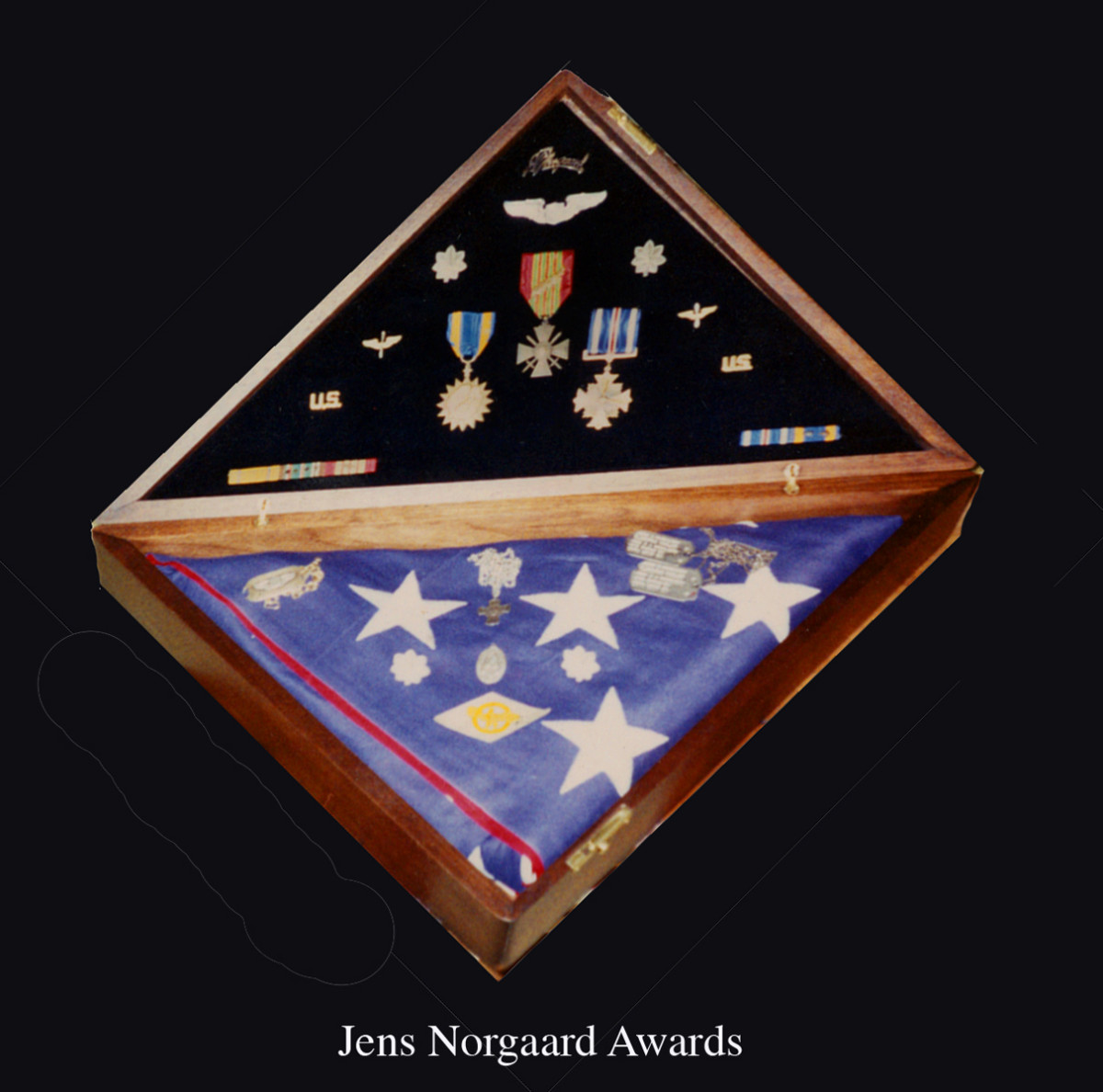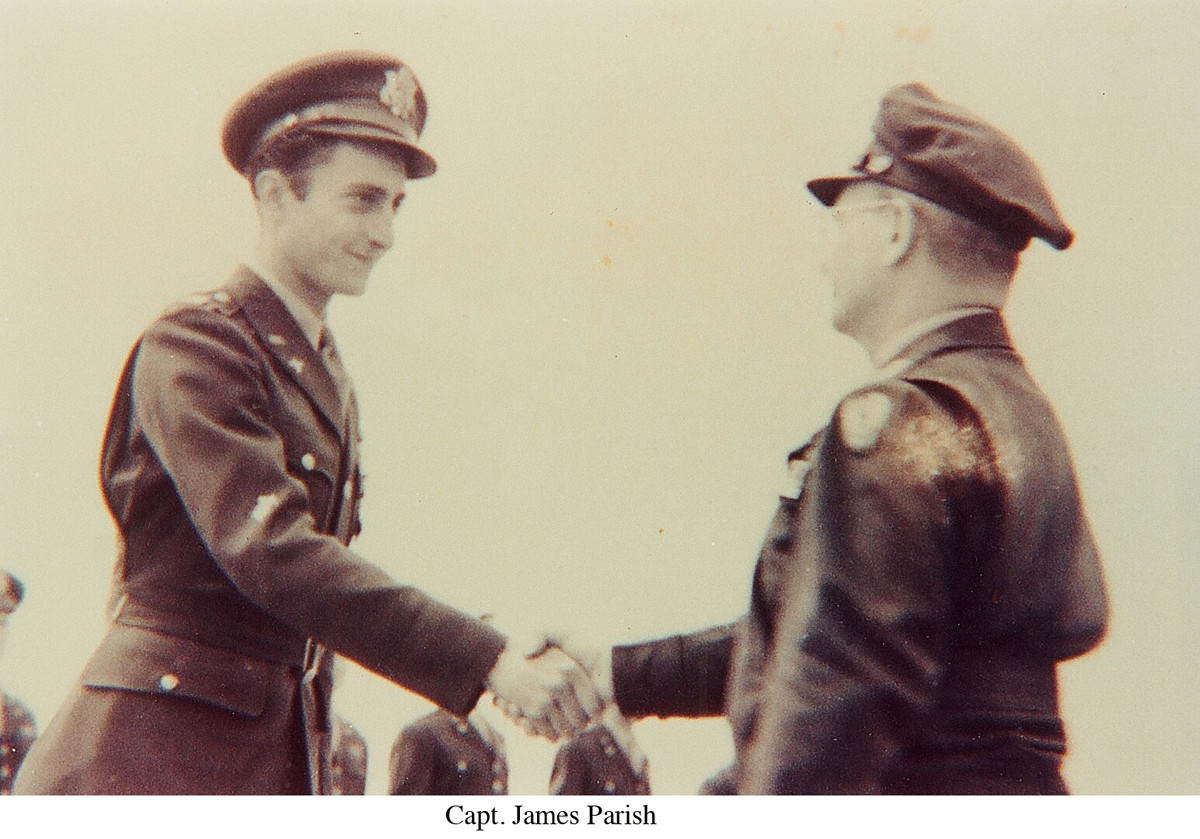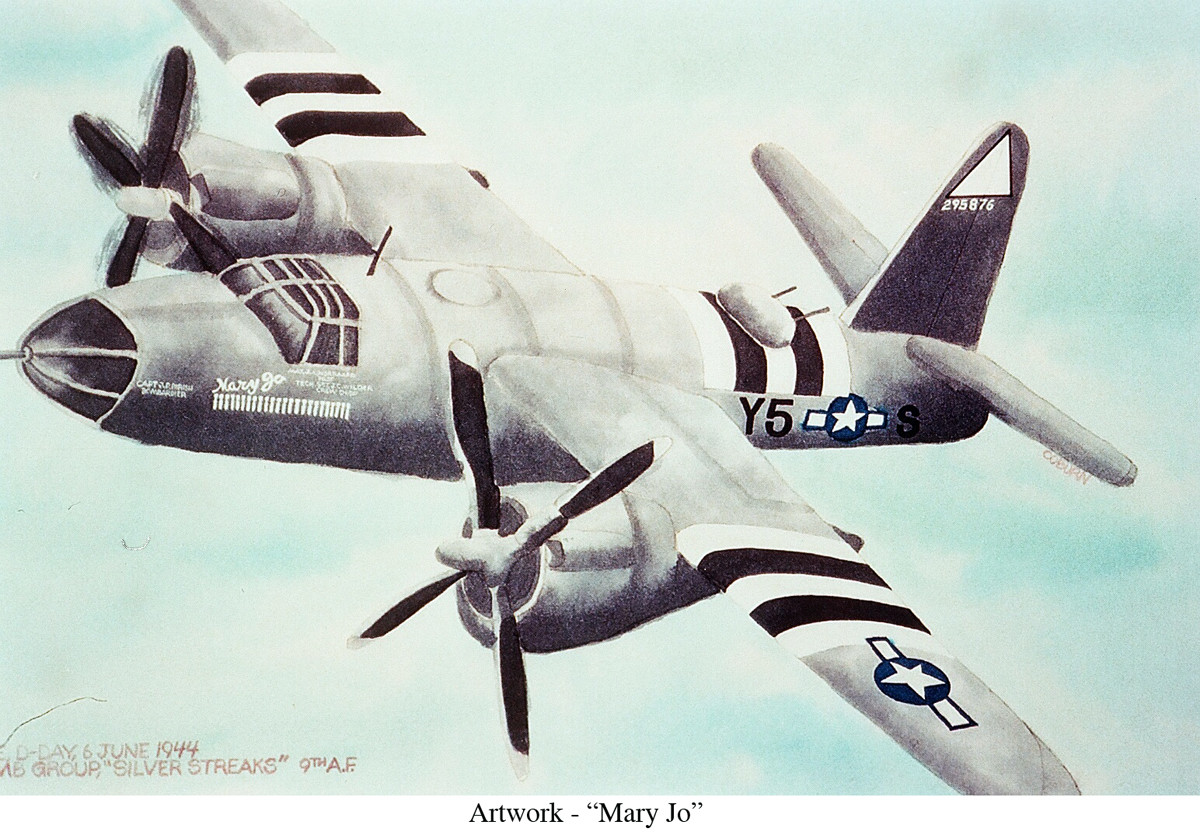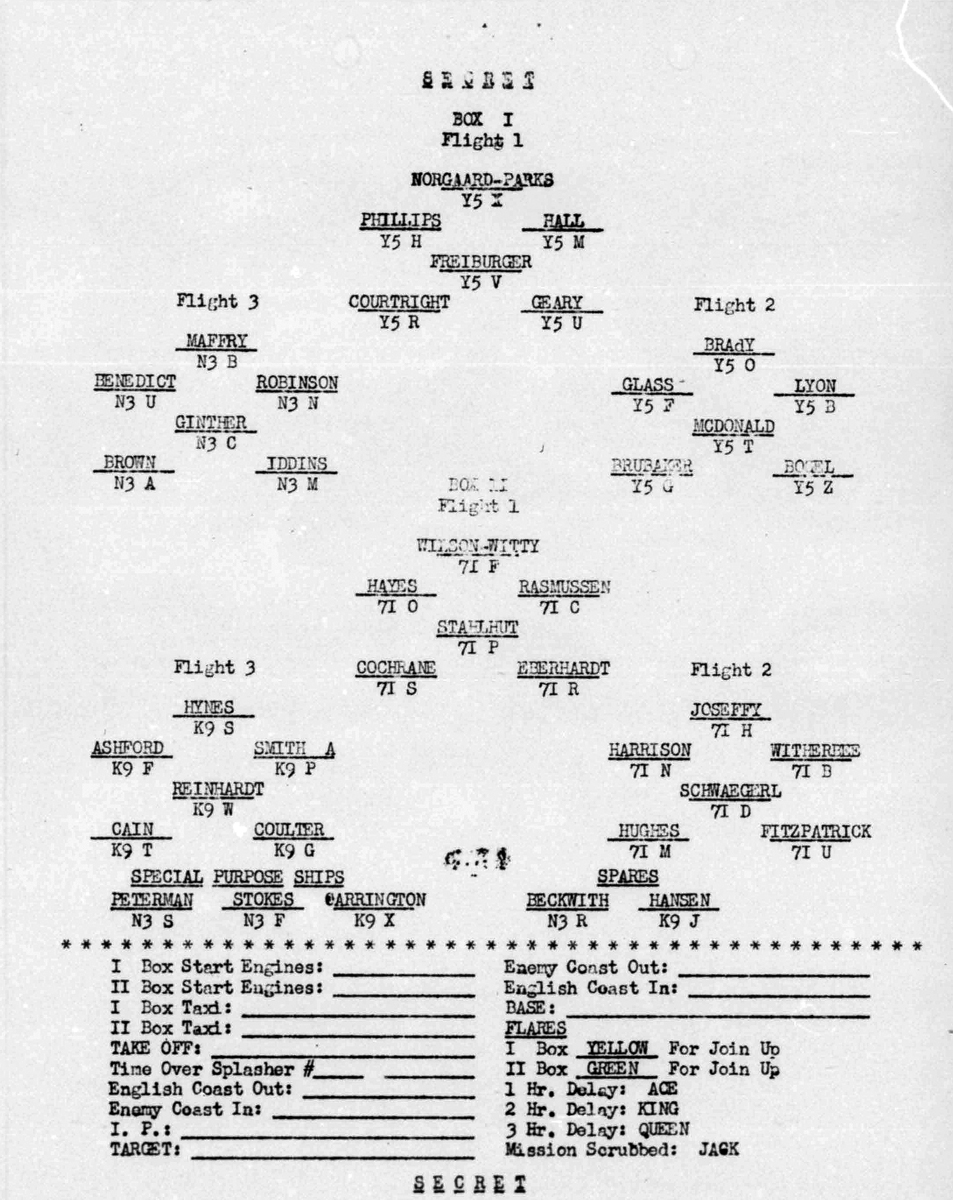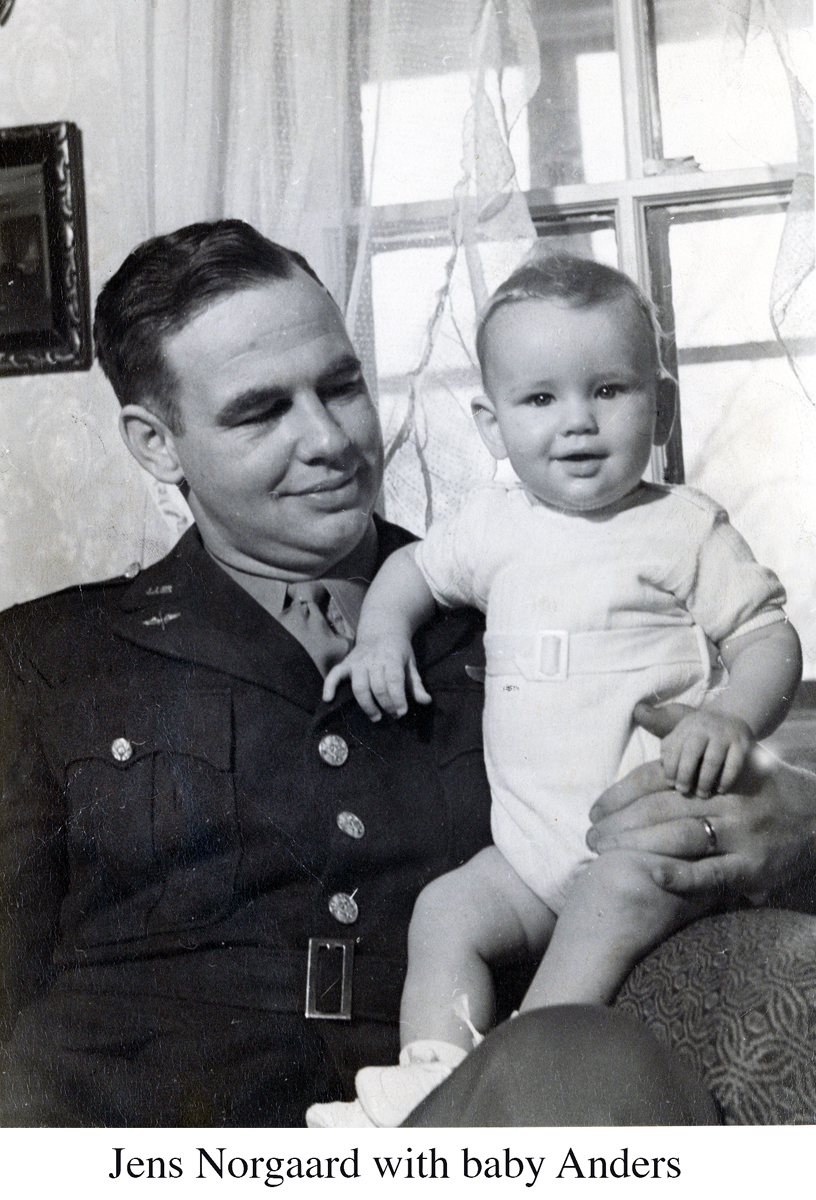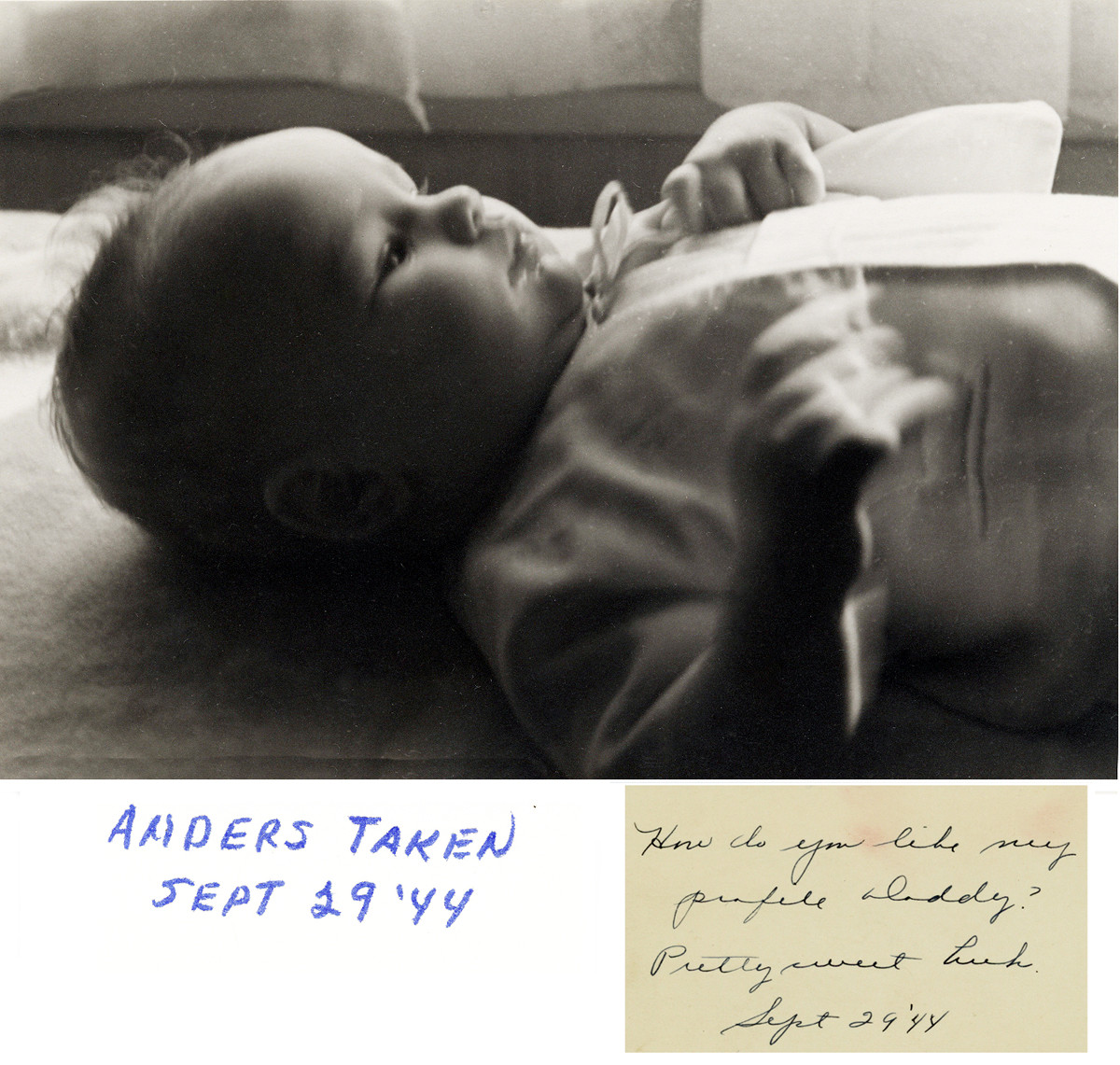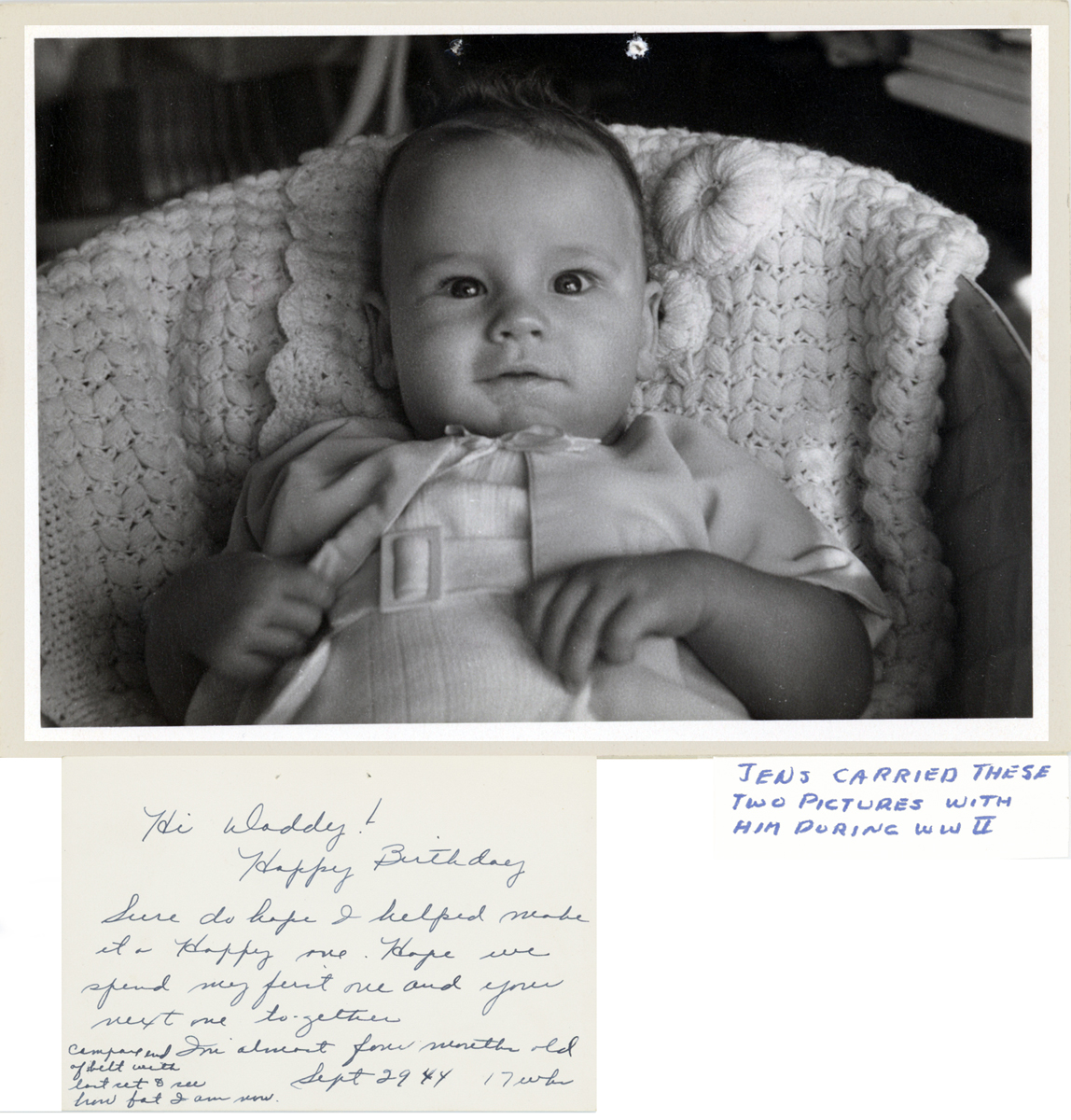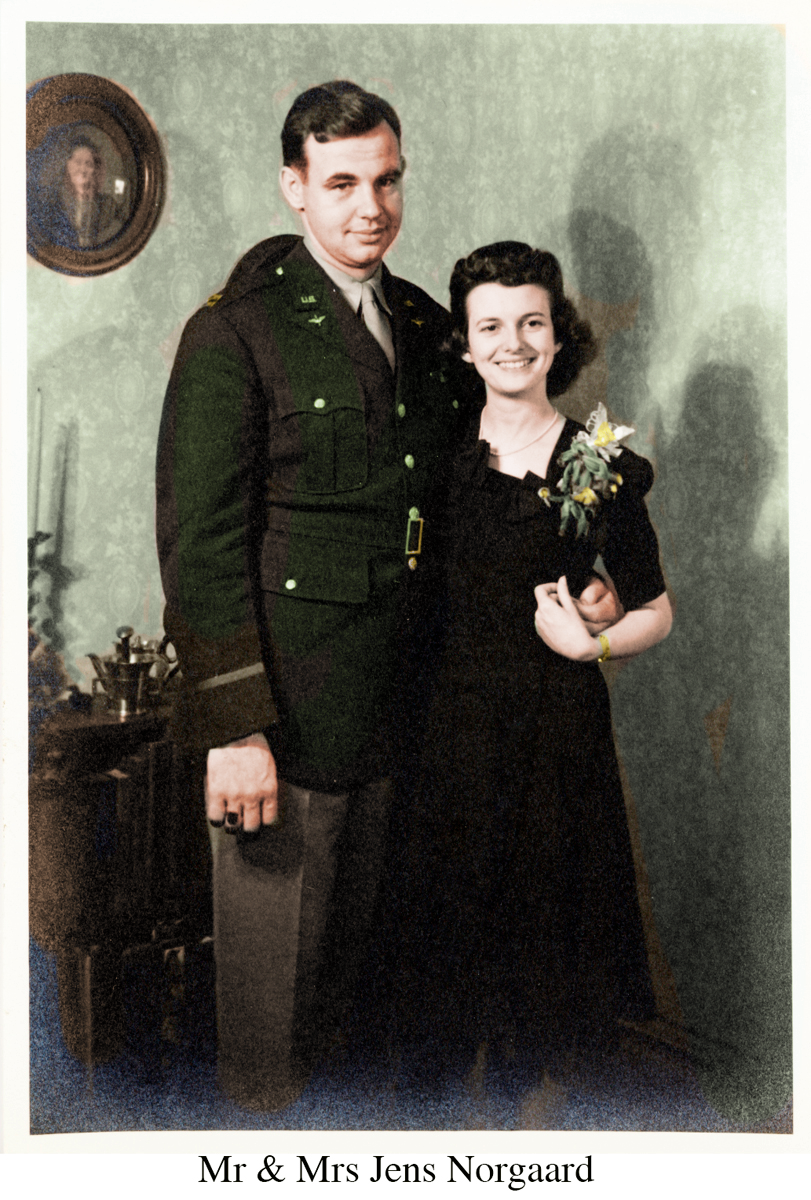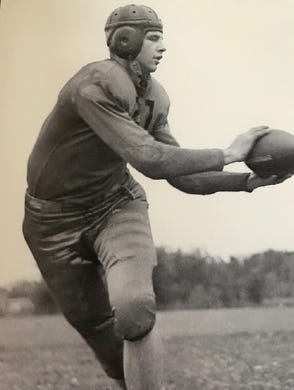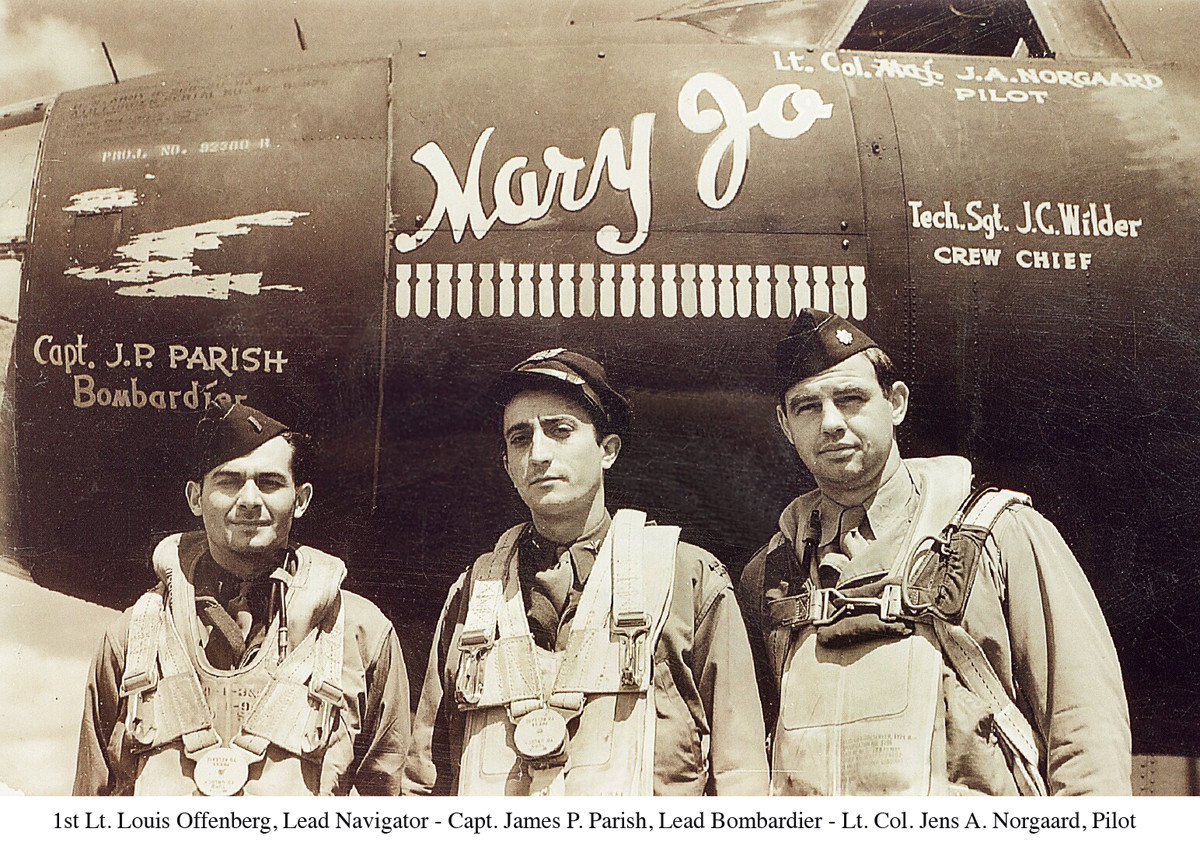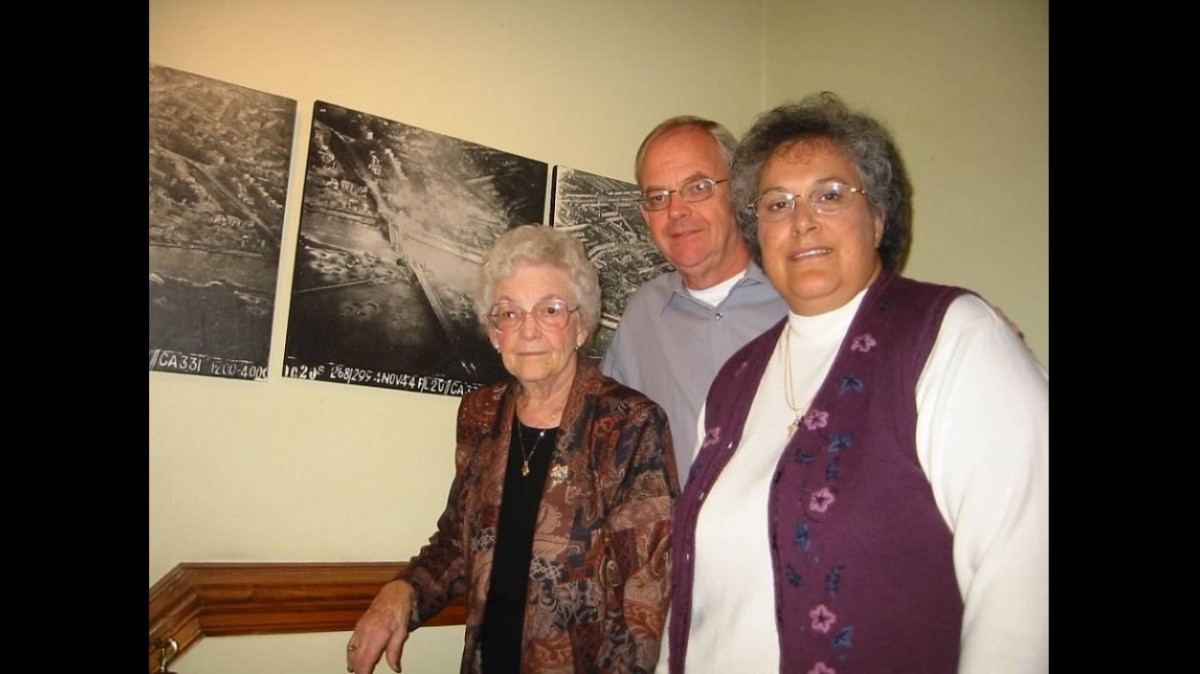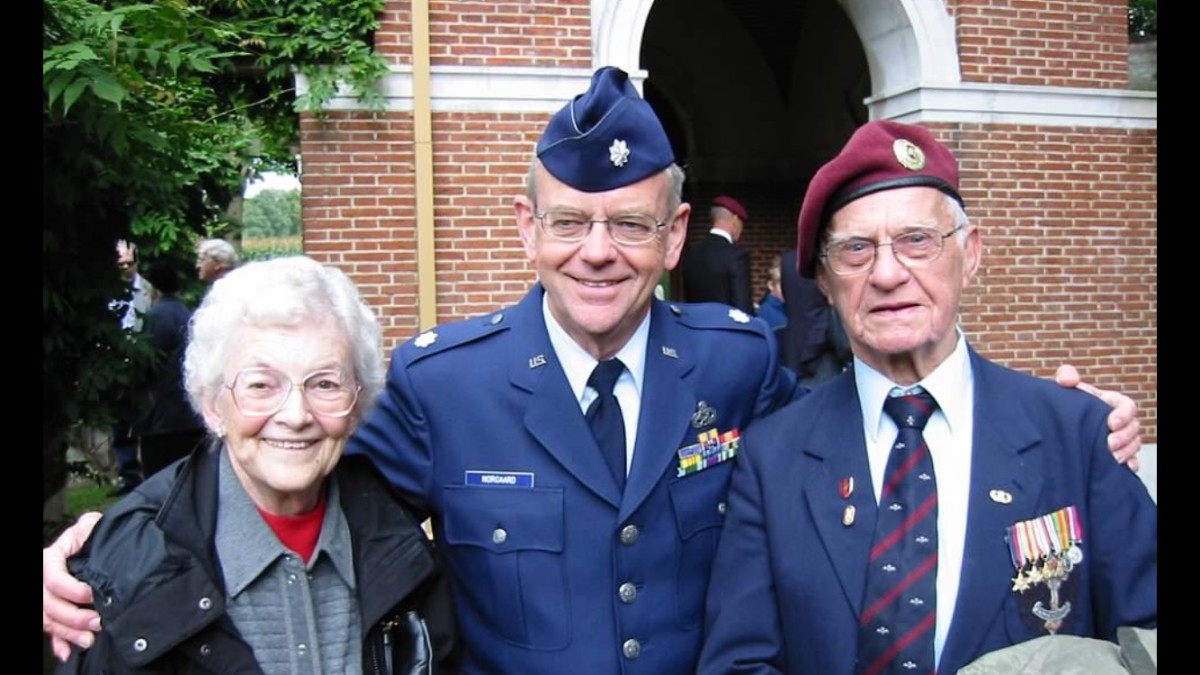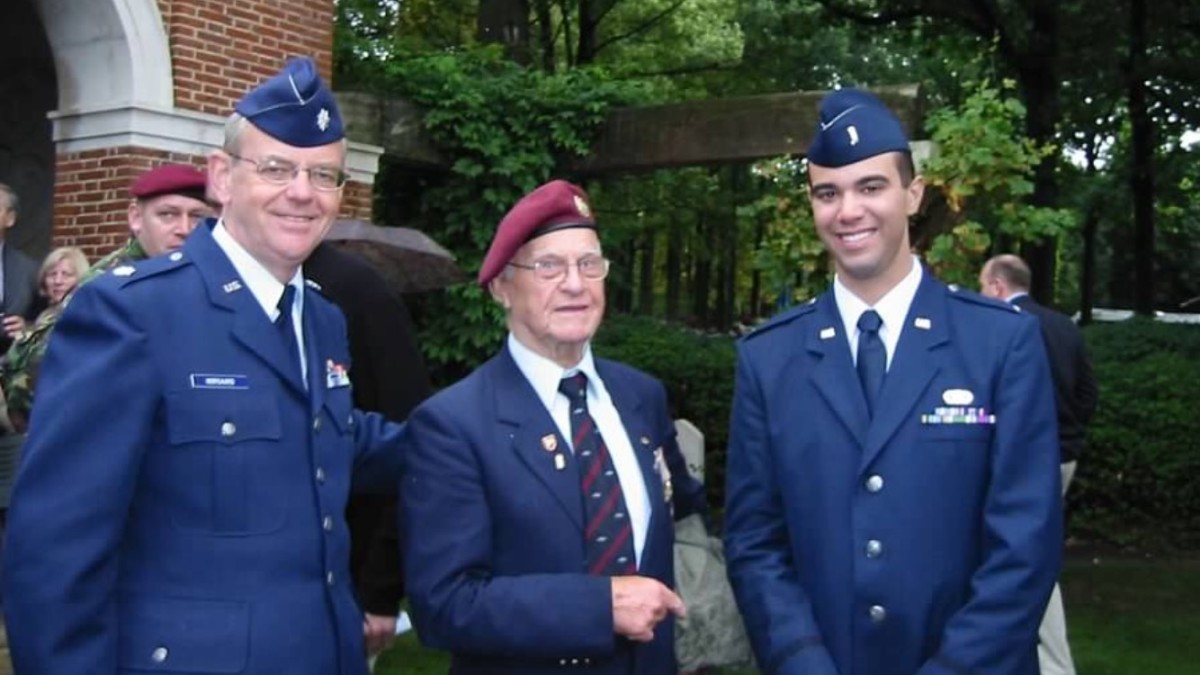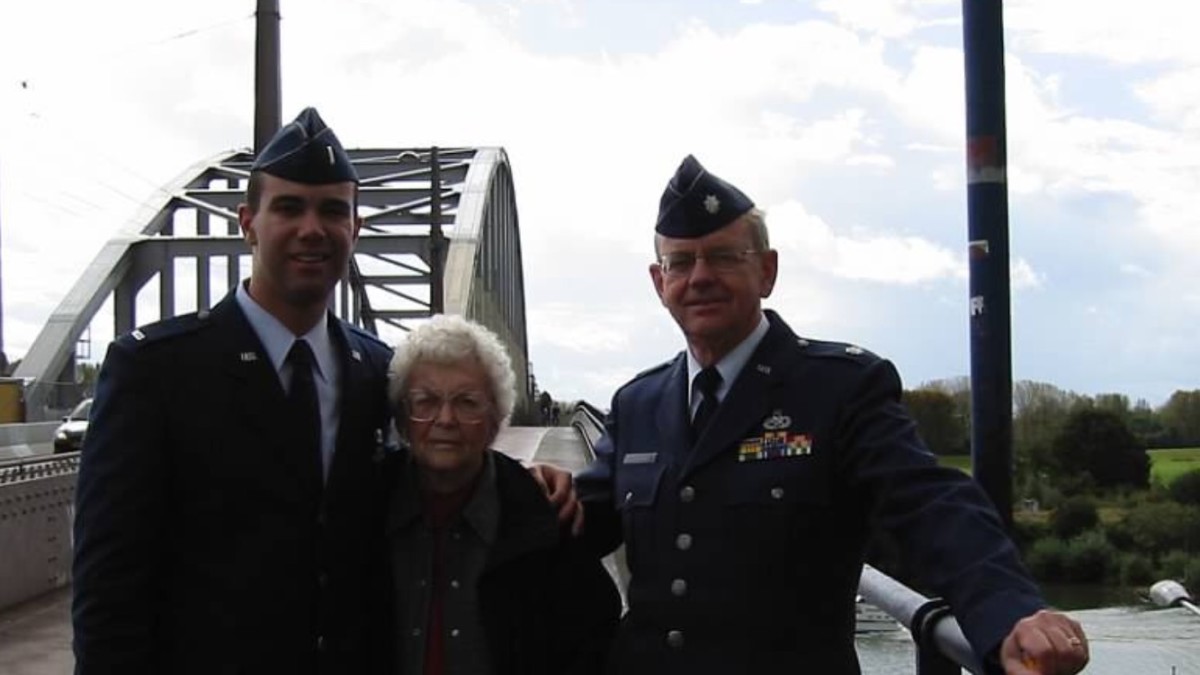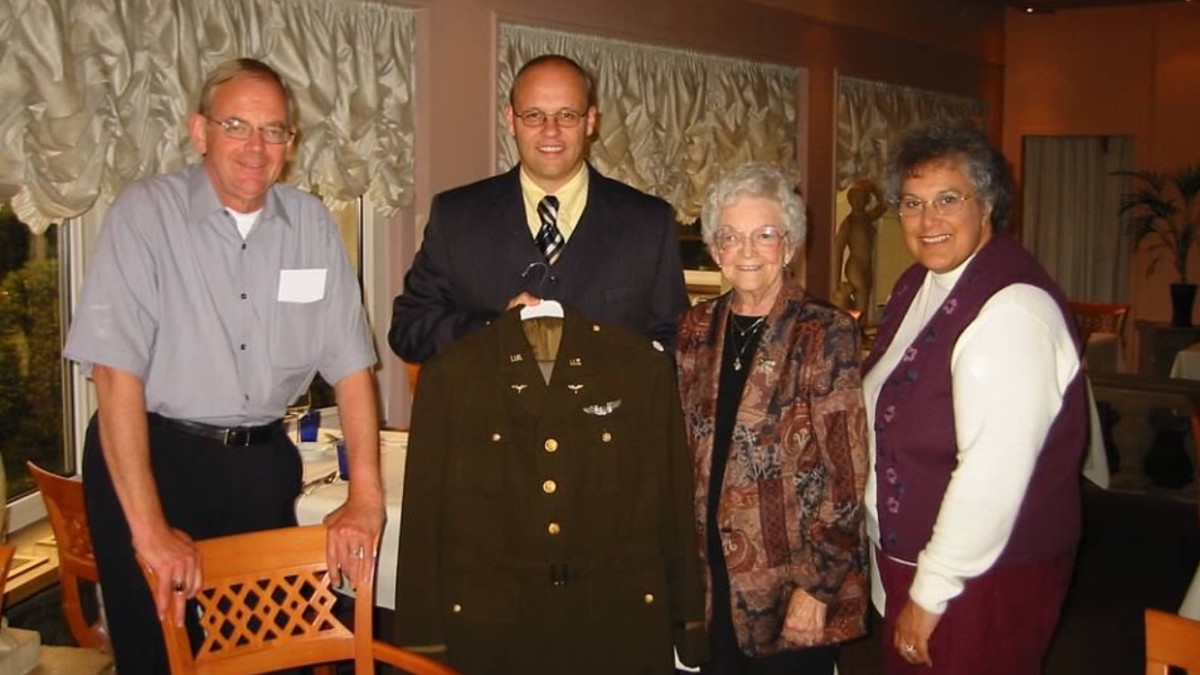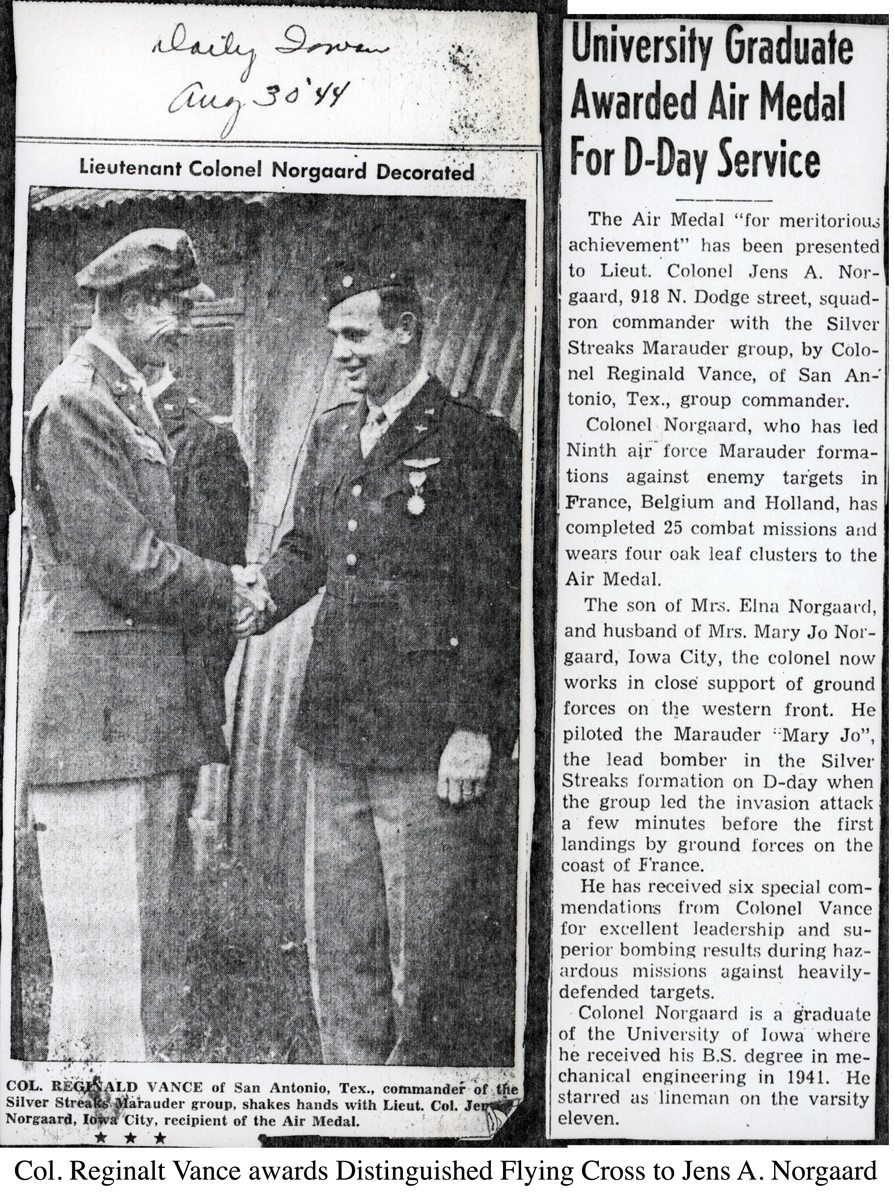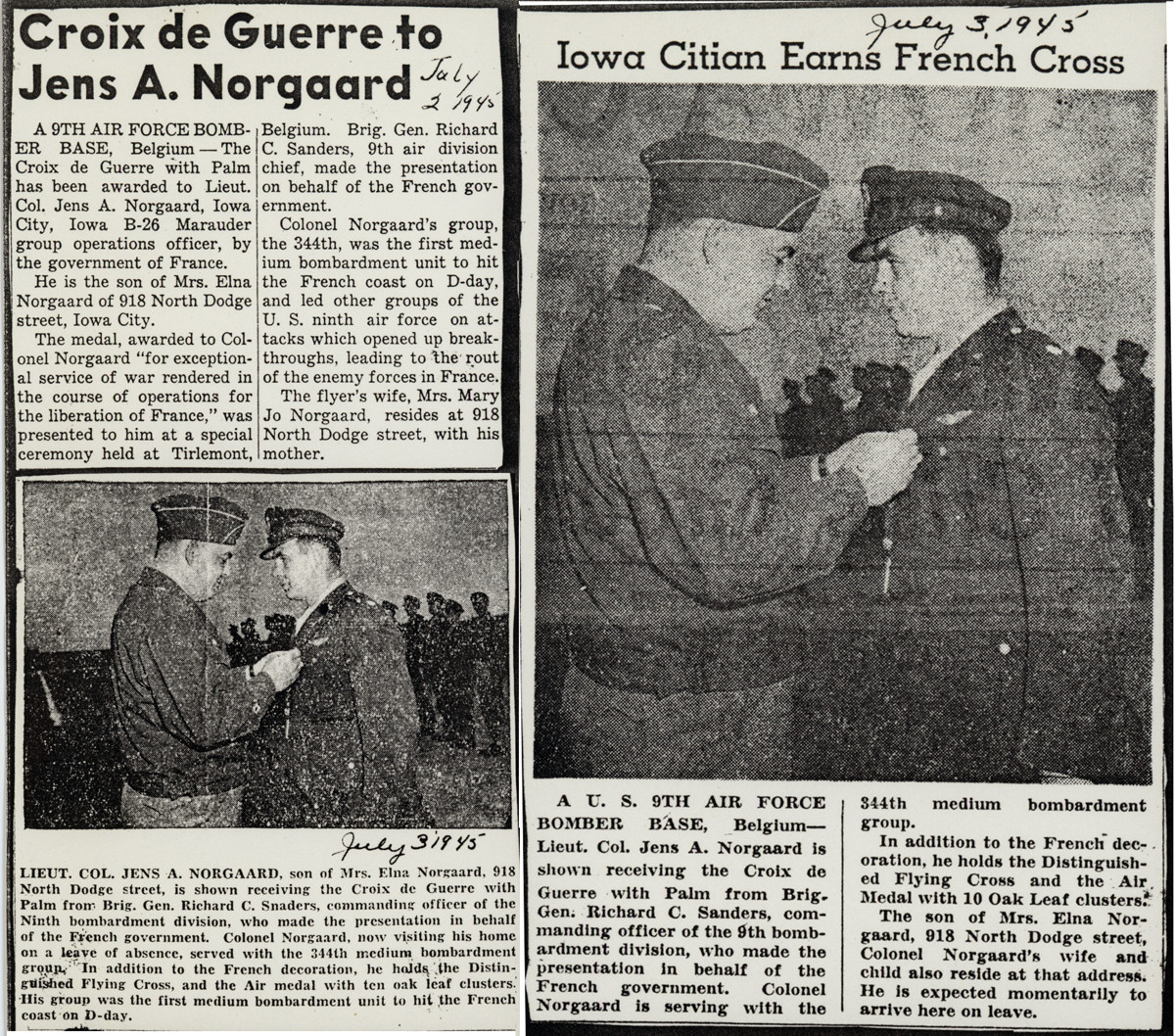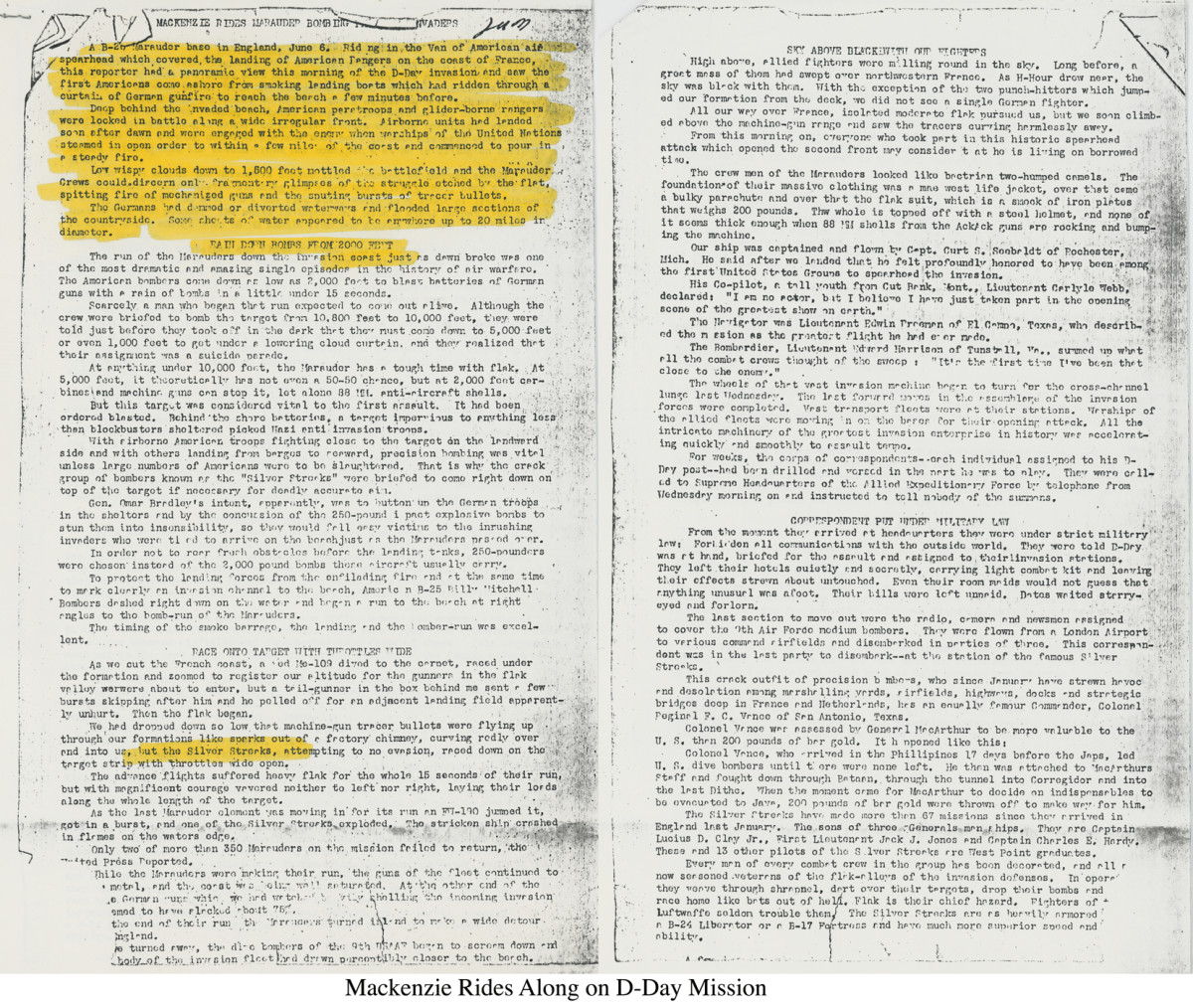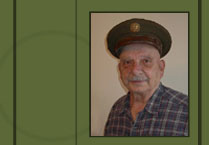Col. Jens A. Norgaard
.Click to enlarge any image.
Jens A Norgaard was born in the Danish West Indies on 25 October 1916 shortly before the transfer of the island to United States. The inhabitants became U.S. Citizens unless they preferred to remain Danish citizens. The family decided to become U.S. Citizens and to change their name from Nørregaard to Norgaard. In the 1920s they move from the Virgin Islands to New York City and later to Iowa.
Jens A. Norgaard enlisted in the U.S. Army, Air Corps, as aviation cadet in Fort Des Moines, Iowa, on 28 May 1941. He was trained as pilot. In November 9, 1944, Jens A Norgaard was attached to 344th Bombardment Group holding the rank of Major.
Jens A. Norgaard’s Biographical Letter to L. J. Fradin, written in 1963 is a good synopsis of his military experience (Click here)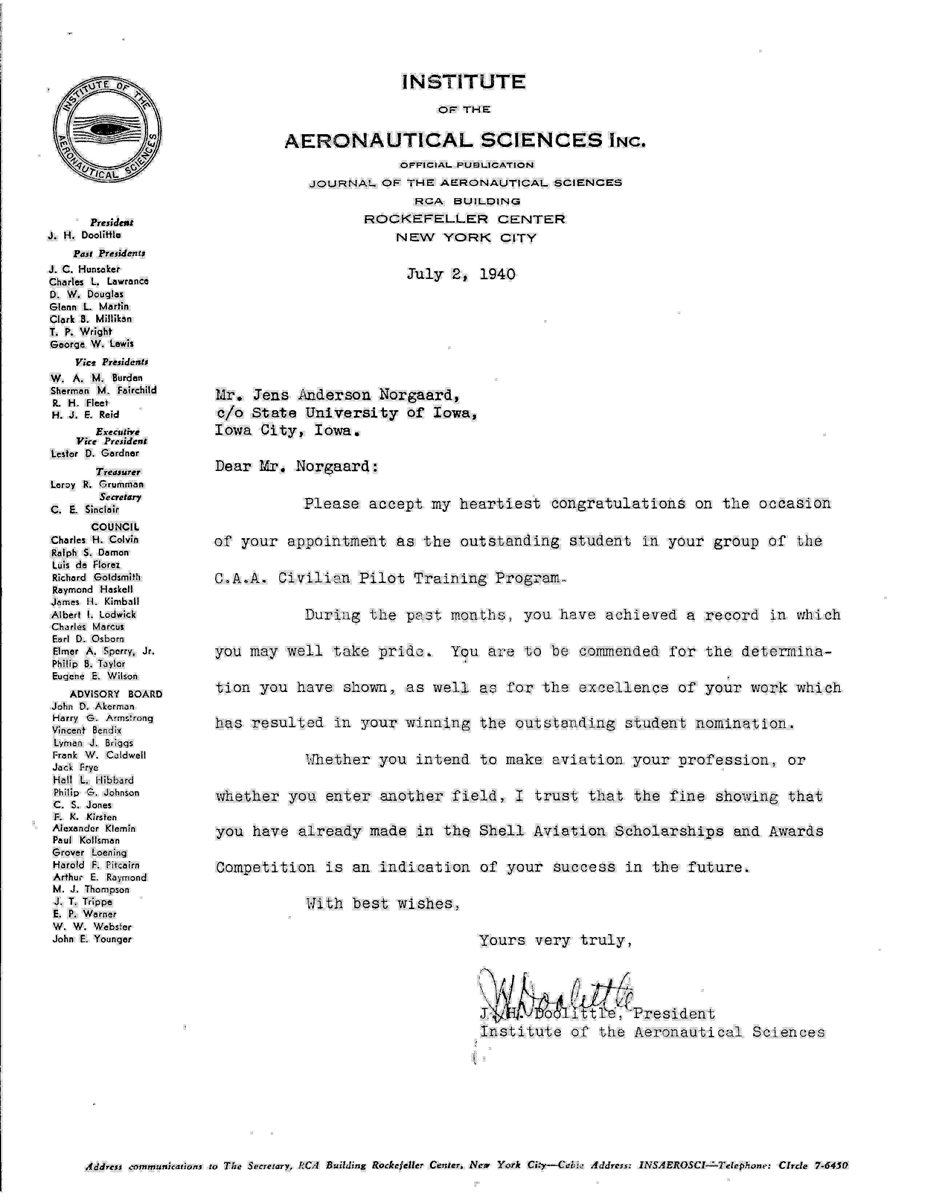
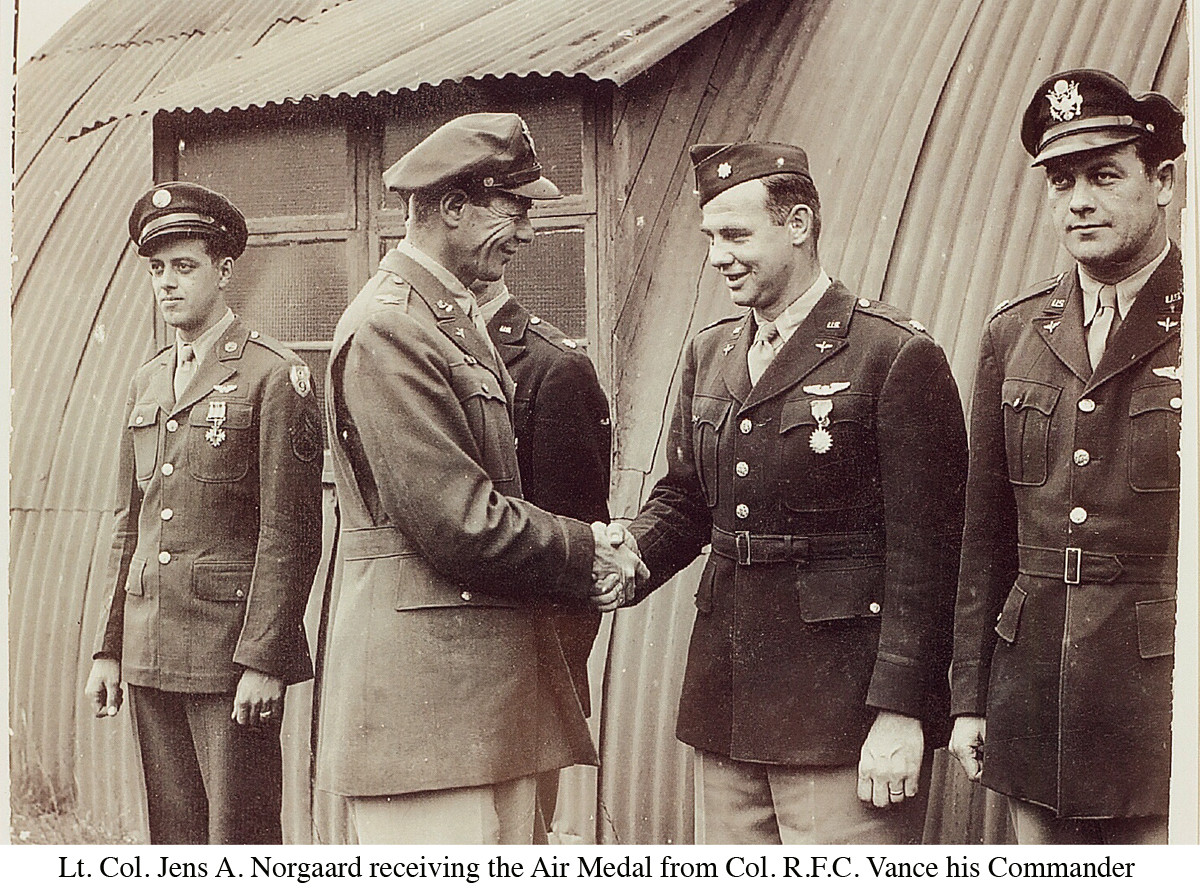
._________________________
On D-Day he was the lead pilot of the Marauder attacks on Utah beach supporting the landing.
The 344th BG was to lead the 387th, 397th, 394th, 323rd and the 386th BGs in the attack of the coastal batteries at Utah Beach and to use small bombs to create “foxholes” for the troops. The first aircraft was to bomb at 0605 hrs and the last at 625 hrs – H-hour minus 5 minutes.
Jens A Norgaard was lead pilot of this formation of more than 400 B-26 Marauders. At 0412 hrs he took off in B-26 (42-95876, Y5-S, “Mary Jo” – named after his wife) from Stansted (station 169). The Marauders found their marks on the ground with great precision and with a loss of only one aircraft, the 344th BG achieved a remarkable success.
USAAF 42-95876 Martin B-26B-50-MA Marauder
USAAF serial number S/N: 42-95876 Martin B-26B-50-MA Marauder named ‘Mary Jo’
Disposal: 42-95876 survived the war and was ferried to the Landsberg, Germany scrap yard with the another 900 Marauders where it had its nose wheel dynamited with 20 lbs of TNT.
.
Back Row left to right: Capt. James P. Parish (killed by FLAK shrapnel when crew flew B-26 “Schiffoni’s” while Mary Jo was in shop for repair), Lead Bombardier; Major Jens A. Norgaard, Pilot and Formation Leader; 2nd Lt. Loris D. Gniffke, Navigator
Front Row left to right: Lt Col. Robert W. Witty, Co-Pilot and Deputy Group Commander; 1st Lt. Louis Offenberg, Lead Navigator; S/Sgt. Kenneth Hobbs, Engineer/Gunner; S/Sgt. Jules S. Theobald, Tail Gunner; T/Sgt. John R. Leach, Radio Operator/Gunner.
.
From 344th Bomb Group (M) “Silver Streaks” by Lambert D. Austin
On November 8, 1942 Colonel John a Hilger designated three squadron commanding officers. Captain William T. Boren for the 494th, first Lieutenant Jewell C. Maxwell for the 496 and 1st, Lieutenant Delwin D. Bentley for the 497th. 1st Lieutenant Jens A. Norgaard was assigned to the 495th on November 9, 1942. These officers, emulating the spirit and determination of their commanding officer, immediately set out to mold their organizations into filing combat unit.
.
Jens A. Norgaard commanded the 495th squadron from its training days in Florida and through its operational status in England, France, and Belgium.
.
D-Day: Following briefing, all proceeded to their planes and began last-minute preparations before take-off. Engines were warmed and at precisely 4:12 AM, June 6, 1944, the first plane piloted by major Jens A. Norgaard, formation leader, roared down the runway and into the air. Every 20 seconds thereafter the remaining 55 planes in succession roared behind him and circled into formation for the flight across the channel, and times to be at their target at 6:09 AM or 21 minutes prior to the landing craft operations of the allied ground forces on the beaches. (Utah Beach)
D-day according to Col. Bob Witty: “I was awakened at 2:30 by the duty orderly bringing a cup of hot army coffee. Sipping a coffee and dressing quickly, I open the group safe in the presence of Colonel Reginald Vance, CEO of the 344th and my boss. We pulled out the sealed orders I brought back from wing headquarters. The role of the 344th was all spelled out. We were selected the distinct honor of leading all allied air power to Utah beach. We would bomb at 6:05 each of the three boxes of 18 ships was assigned a specific target. Major Norgaard and I would lead the first box to a landmark called LaGrand Jeune and attack a fortification known as Willderstandnest 5.”
Witty continues, “It became obvious as the formation roared south of London toward Buncher Beacon “Ford” that we could not bomb at 12,000 feet. Norgard, codename “Pawnbroker 1,” nosed the group down to 10,000 feet. Then to 5000 feet. Our bombardier, Captain James Parish, thought he could bomb accurately at 3500 feet, if the weather and visibility suited major Norgaard. Each of our three boxes have been assigned one of the three coastal batteries embedded in solid concrete. It’s suited major Norgaard just fine. The weather has begun to improve, just like the weather sweats had predicted.”
_________________________
Battle of the Bulge: On December 18, 1944 the target was Herhahn, a defended town. The 495th squadron under Lieutenant Colonel Norgaard attacked Herhahn. This defended town was successfully bombed by use of Pathfinder equipment. As has been usual for the missions in December no flak was encountered.
B0296 interrogation p168, p143 Load List, p134 Formation diagram
.
.
.
After the war: Lieutenant Colonel Jens A. Norgaard, who commanded the 495th bombardment squadron during his training days in Florida and through it’s operational status in England, France and Belgium, was transferred to group headquarters on May 25, 1945 and served for a time as deputy commanding officer. On June 19, 1945 he received orders to the 70th reinforcement depot in France, for return to the United States for further assignment.
.
Harry Loveless remembers: “In preparation for becoming a flight leader, I flew copilot on March 20, 1945, Mission number 22, with Colonel Norgaard, Box 1.” “Later, on March 31, 1945, I led C flight in Box 1. I was severely criticized upon returning to base because our flight’s bombs had missed our assigned target. We had released our bombs while in a bank rather than while flying straight and level. One more chance, Lieutenant! I held a serious conversation with Charlie, our bombardier, and we were given a second chance.”
Jens A Norgaard died on 24 September 1989 in Florida.
.
Letter from Mary Jo Norgaard to Mabelle Parish July 2006;
.
Dear Mabelle,
My son James Norgaard found your letter on this website. It was great to relive memories so many years later. He felt you might like to hear a little more of the story.
I am the Mary Jo, Lt. Col. Jens A. Norgaard named his plane after. His parents were both Danish, not Norwegian. He was born in Danish owned St. Croix. I am 91 years old and still have a mind and memories of your Jim (that’s what we called him).
Jens and I were married in March 1943, he died in September 1989. We lived in Lakeland, Florida where Jens was Commander of the 495th Squadron of the 344th bomb group of the 9th Air Force.
His group had been picked to train new B26 Crews after we lost so many of our B26 Crews to Hitler’s Rommel, “The Fox” in the African Desert in 1943.
When their group left for Europe in January 1944, Jens handpicked his crew. James Parish was the group’s best bombardier and Lou Offenberg was the most outstanding Navigator (We still keep in touch with him). The family met with him in Florida after Jens died and he told us all about D-Day` which we taped. Lou had special Celestial training.
Col. Witty said the D-Day Mission was miraculous. It was!
I dedicated Jens’ plane to the Blessed Mother and St. Joseph when he named it after me. A month before D-Day when they were practicing the D-Day formation, Lou Offenberg noticed a lake that wasn’t on his map. He asked Jens why. Jens told him it was in front of the palace and not marked to protect the palace from German aircraft. Lou marked his map.
On D-Day the weather was so bad Col. Witty wanted to abort the mission. Jens insisted they could do it with his great crew.
When they had the formation together about 15 minutes before they were to drop their bombs, Jens asked Lou where they were. Lou answered, “I don’t have a ghost of an idea.” Just at that moment the clouds opened over the lake in front of the palace. They knew where they were and dropped their bombs on all their targets within 20 seconds of the target time.
They opened Utah Beach so our men were able to land safely, while the U.S. 8th Air Force missed their target on Omaha Beach and dropped their bombs 3 miles inland, causing the deaths of so many of our men.
I learned this in 2002 when I went to the Dedication of the Museum at the Arnhem Bridge in Holland with my son Lt. Col. Anders J. Norgaard and his wife Geraldine. Jens and his crew with Jim and Lou had destroyed the important bridge after many other crews had failed.
On a mission sometime after D-day, Jens was flying one of his group’s planes, “Schiffoni’s” because the Mary Jo was being repaired. While your Jim was leaning over the bombsite a piece of shrapnel came through it and struck him in the forehead. Jens dropped his bombs and immediately turned the plane around to return to their base, as Jim was thought to be dead, but when Jim moved suddenly, Jens changed course to the nearest base to get help. But, Jim died there. Jim was the only one of Jens’ crew that he lost. No one ever died on the Mary Jo.
July 24, 1944. Tours/LaRiche RR Bridge Squadron Navigator, lost his life on this mission for which he was the Lead Bombardier. (494)
Capt. James P. Parish (KIA)
When we defeated Japan, Jens was released from the service in California in August of 1945. Where he had been sent to join the war against Japan, after returning from Europe. He and I went to visit Jim’s parents, after his discharge, to give them the details of his death and his life with the group, and to comfort them.
.
I forgot to tell you, our son Anders was born on June 4 1944, two days before D-Day. Jens didn’t know of his birth for 2 weeks, all communication was stopped, as you know.
I have kept in touch with Lambert Austin who has been writing a newsletter every few months for years. I had also kept in touch with Carl Christ and his wife Edna, who were part of the 344th. Carl has gathered a great deal of information for the museum and the B26 groups. Carl died in 2005.
.
The success of the D-day mission would never have been so great, had it not been for James Parish’s expertise as a bombardier.
.
Sincerely,
Mary Jo Norgaard
.
D-Day according to Bob Witty
Commanding Officer, 11-7-44 to 8-17-45
344th Bombardment Group
I was to fly this mission as Command Pilot in the copilot seat with the lead crew, a be-medalled outfit which had led the Group again and again and was a typical polyglot American bomber crew under the command of Squadron Commander Jens Norgaard who had trained them since their fledgling days at MacDill Field in Tampa. The crew consisted of a Norwegian, two Jewish lads, two Irish, a Pole and a Hungarian.
Under Norgaard’s methodical pre-flight checking we reviewed emergency bailout procedures, inspected our French Franc issue in our escape-kits, our flak suits, our emergency rations, our pistols and maps; this careful attention to detail, the crew knew, might tilt the odds in their favor in case of a bailout or crash landing.
The banter of the mess was gone; in its place was a professional grimness, a stoic but confident attitude toward their mission. This was a crack crew, flying its 20th mission together and nothing would be left to chance.
With his wing lights stabbing twin holes in the misting night, Norgaard led the Group, like so many pachyderms, nose to tail, down the taxiways. Thin down the runway that night, with the fabled “metallic-taste” in their mouths, I’m sure my fellow crew members had their fingers (figuratively) crossed, as I did, in a nod to Lad Luck.
I mechanically helped Norgaard get the Mary Jo (named for his wife) into the air and having lived with the perils of this mission for a week in my mind I was echoing my last word at the briefing, “Godspeed.”
Joining up 54 twin-engined bombers on a clear night was not easy; assembling them on course at 12,000 feet on a rain-swept night between clouds layers, was miraculous. Inside Mary Jo the instrument lights cast a dancing, eerie-colored glow throughout the cockpit. Climbing through the clouds, the running lights of the other Marauders as they skillfully formed up on the leader, were reassuring. In 20 minutes we were formed and on course for one of the most memorable flights any of us would ever fly.
The three “boxes” of 18 planes had different targets on the Cherbourg Peninsula, but would stay together over the Channel and separate only for their bomb runs in to the individual aiming points. It was obvious as we roared South of London that we could not attack at 12,000 feet because of the clouds. We nosed the formation down to 10,000, then to 5,000 and then a bit lower. From there it was still possible for the bombardiers to use their Norden sights. Just barely.
As dawn spread slowly up out of the East, on the surface of the choppy Channel we could make out the magnificent armada of 10,000 Allied slips bearing thousands of men to a rendezvous with history – a rendezvous that many would not survive. It was a riveting sight that none of us would ever forget: the largest assembly of ships and men and power the world had ever known.
The tension mounted as the gunners tested their twin 50-caliber machine guns preparatory to approaching Utah Beach; a crackling clatter so much a part of these methodically choreographed missions.
Our targets, three batteries of concrete-imbedded coastal guns East of Cherbourg, on the Contentin Coast, were coming up fast now. The most vulnerable period of a bombing mission occurs when the aircraft has to be steadied on a level, straight-in course; flak and fighters make this brief, suspenseful period a veritable hell. But today the German fighters had been swept from the skies and the anti-aircraft fire was desultory, inaccurate.
The Group honed in on the massive gun emplacements and arrived at the three aiming points within 20 seconds of target time. One could sense the relief in the crew as the aircraft lurched abruptly with the launching of 2,000 pounds of bombs and the cry of Bombardier Parish, from his plexi-glass perch in the nose, “Bombs away! Let’s out of here!” Norgaard wheeled formation back out over the Channel, through a thin layer of clouds and spotty rain squalls. Mission accomplished.
I sensed a collective sigh of relief in our plane; there is a release of tension after a bomb run that crackles through the crew. The actual danger is not entirely over, but the most perilous moment is behind them.
Leveling off and heading for base, one of the aircraft in the third box received a direct hit from the sporadic ground fire and it was up on one wing, sliding fast toward the water trailing black smoke, a fiery doomed comet; no one witnessing a mortally wounded, blazing bomber on its final plunge will ever forget it. In my own case, it remains seared into my memory.
Later, when we arrived at base, BBC was to say that of the eight Marauder Groups involved that day, “Only two planes were missing of the 400 which struck the German fortifications.” Only.
Only 12 young men, lost in their prime. Only 12 families notified and destined to mourn forever. Only 12 sweethearts or wives left to ponder celebrating the “Return of the WWII Americans to East Anglia,” I hated it just as much as in the angst of that moment in 1944.
Norgaard touched the Mary Jo down gracefully and whilst flak jackets and helmets and woes were shed as he wheeled into the handstand, I knew what to expect: with the tension of the mission behind them, these very young men (only two on that crew were over 22) burst into talk; giddy, tension-relieved chatter that proclaimed, “We made it!”
Witty describes Norgaard- “From Iowa, bigger than life Jens Norgaard brought to the 4/95 his rich football background and gentle giant firmness. As conscientious as he was huge, he never the less was a pussy cat when the situation calls for it and much to my delight he insisted on driving to the inside streets for the duration.”
Email from Mabelle Parish to Carl Carrozza (webmaster/historian)
Hello Carl! You can not imagine how very surprised I was to get your email! I cried reading your account of my uncle’s (Captain James Parish) last moments before he died. I know that he was still breathing after this incident, because they turned around and headed back to England in hopes that he would live…I believe they pronounced him once they landed. Of course I never knew my uncle, but in a way I did because of all the stories about him told by my father, my grandmother and grandfather. I do not believe this information was ever shared with my family because it was never mentioned when recounting that my uncle had died as a result of a piece of shrapnel penetrating his helmet. I’m glad it was not…as it would have only added to the sorrow with the inevitable “If onlys.” On the lighter side, we (the nieces and nephews) used to think that the story of the Mary Jo and my uncle dropping the first bombs was just family folk lore. When my father (who had retired from the Air Force with honors in 1964) died in 1995, for some odd reason I got the boxes of “papers” that had been in my parent’s attic.My mother had passed away in 1986. About five years ago I rediscovered the box and went through it…it was a treasure chest of papers, letters, and flight books. The letters were such a wonderful peek into the lives of my two uncles (Perry & buddy) and my father’s while the Parish brothers were in the war. My father served in China/Burma/India and my uncle buddy served in the pacific while Perry, of course was in the European theater. There were letters to and from each of them and letters to my grandparents back at home in Montgomery Alabama. I cried a lot reading those letters, in particular the one I found that Perry had written to my father just before D-Day. He talked about the great sacrifice that would be made and that future generations would know and understand that freedom would be soon won. I also found the telegram the War Department sent to my grandparents informing them of Perry’s death. My grandmother never got over his death. I have pictures of her prior to the summer of 1944 and she was smiling…afterwards, pictures of her smiling were almost non-existent. She told me one time about an incident that happened several days before the telegram came. She said she woke up (very clear that she woke up) because she felt someone pulling her big toe…the signal that my father, and my uncles used to let her know they were home after being out. She said she saw a very bright light and my uncle Perry, with an angel standing behind him, was in this light. He told her: “Mama…I want you to know I’m home safe and don’t you worry about me.” The next night she had a dream where she was standing in the living-room looking out the window at the street that ran in front of their house. She saw the Western Union boy on his bicycle coming up the street. She began to scream “Don’t you come here….Don’t you come here…” He then stopped his bike at the their steps….she said she woke up. The next morning she was in the kitchen preparing my grandfather’s breakfast and his lunch box.(He was a switch-man for the L&N Railroad) He was in the bathroom shaving. She happened to go into the living-room for something and saw the Western Union boy coming up the steps. She began to scream for my grandfather who came out of the bathroom with lather still on his face. He was the one to answer the door and receive this terrible telegram that would forever change not only their lives, but the lives of my father and uncle buddy as well. When I found this telegram I sat and cried for what seemed to be a very long time. I absolutely could not imagine the incredible heart break of my poor grandfather standing there with shaving cream on his face and reading that his first born, the big brother hero of my father and my uncle buddy, was dead. For that matter, what an awful job it must have been to be a Western Union messenger during the war years. My uncle was buried in England until the end of the war, and then he was brought home for burial in the family lot in Montgomery. My grandmother was so distraught she was not able to attend the funeral. Col Norgaard and his wife Mary Jo came to see my grandparents and gave them as much comfort as possible. Col Norgaard spoke so highly of my uncle not only as an excellent well thought of crew member but as a well respected man of integrity and honor. This, I believe did help them as much as anything could. My grandparents always talked about how much respect they had for both Col Norgaard and his wife. I also happened to find the letter Perry’s fiancee had written to my grandmother after his death. This one really made me cry because of the realization that I never got to know my uncle and this woman who would have been my aunt and the cousins I would have. I had this deep sense of loss for what might have been. Her name was Pat. She talked about how she could not imagine the pain and heartbreak my grandmother was suffering, because she knew the depth of the pain and agony she was experiencing. She talked about the life the two of them had planned, and the very deep love they had for each other. She noted that she had enclosed her engagement ring as she felt my grandmother should have it. Several years ago I received an email letter from Mrs. Norgaard…she was 91 at the time. She told me about the Mary Jo’s mission on D-Day and the bravery of every crew member. Carl, I gave all the papers (including the flight plan for the morning of D-Day and sure enough there was the Mary Jo in the lead!) to my brother who retired from the Air Force in 1996 after a distinguished 24 years of service.I believe the email letter from Mrs. Norgaard was among those papers. I will contact my brother and ask if he can scan it and send it to me and then I will forward it on to you. The contents of this letter is not only about my uncle but also some very interesting facts about the bomb run itself. Thank you so much for answering my email….I’m going to share with my family the information you gave me. And about the picture…yes I do have it. That picture and the “official” Army Air Crop photo of Perry sat side by side on the bookcase in the living-room right next to my grandparents chairs for as long as they lived in the house on Highland Ave. I now proudly display them on one of my bookshelves! Again thank you so much for contacting me!
Mabelle Parish
__________________________
Norgaards in Arnhem:
Newsclipping:
